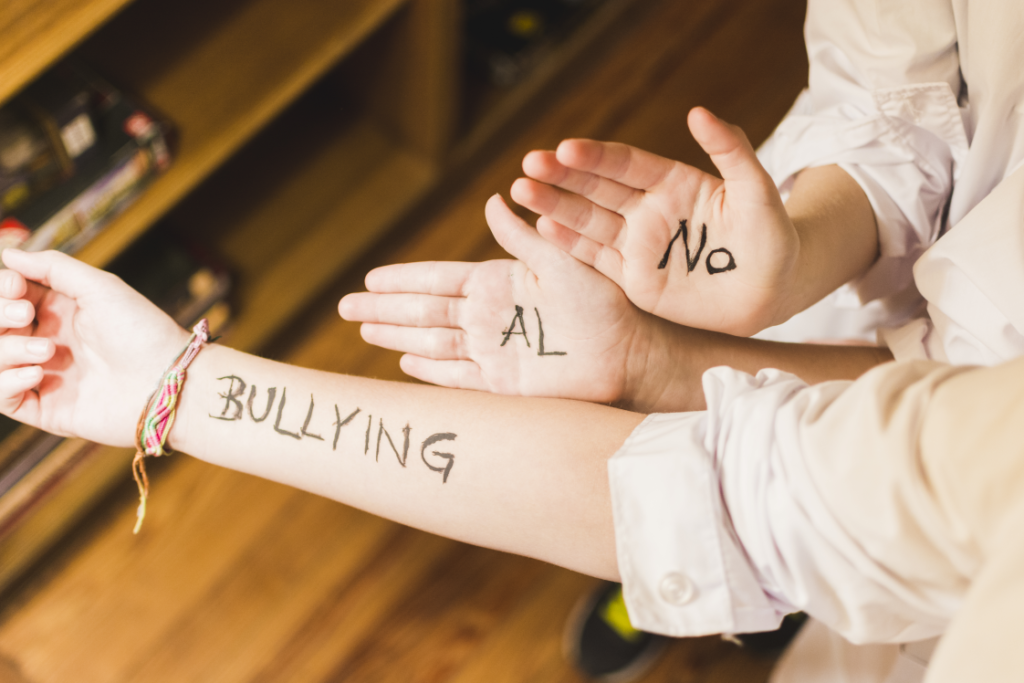Bullying S.O.S.: how to encourage self-discipline teaching yoga to children

The word bullying identifies with a repeated aggressive behaviours towards others who cannot defent themselves.
I would like to talk about bullying under the perspective of the Yoga teachings in order to give you some suggestions to manage this phenomenon in the classroom and to prevent it, as well.
The very core of Yoga wisdom is to free the human being from the oppression of the ego, which behaves such as a capricious child that forces the mind to bend under its multiple wishes.
Let’s start from a fundamental verse from the Srimad Bhagavatam (14.579 stanza divided into twelve sections. Its main theme is Viṣṇu intended as a manifestation of the cosmic personality).
“The ones who consecrated themselves to Yoga, just live for the wellbeing, the progress and the happiness of others; they do not pursue personal goals”.
Srimad Bhagavatam
That path of Yoga that promotes disinterested actions for the good of others is called Karma Yoga (or Yoga of the unselfish action). We could define Mother Theresa as a perfect Karma Yogi.
Just think of your mind as an “operative system” where specific programs have been installed that serves the “adaptation to reality”.
One of those programs is to execute a behaviour just if it helps in pursuing happiness or at least to avoid suffering.
Please follow me carefully. Even who commits the most abominable action on Planet Earth is driven by the same reason: either reducing suffering or obtaining more happiness, which are actually both the same thing for our mind!
Therefore, children who bully are doing this because their most deep intention is to find happiness. In this scenario, their actions might satisfy the bully need for “importance”.
Now I get to the heart of the matter. Children can choose to satisfy their needs in two ways: an illusory one (that will bring about suffering) and a beneficial one (that will lead to happiness).
In order to understand if a need is being satisfied in the beneficial way, just take into consideration whether it brings improvement to others or not.
Let’s take for example a child that helps his classmates in their homework in order to feel important. This is surely beneficial.
Instead, the illusory way is when the child causes others to suffer. Violent behaviours worsen his Karma and as a consequence that will bring him to suffer and to pay off the consequences of his own actions.
Let’s sum up:
Children always act in order to obtain happiness and bullying is an illusory way to try to satisfy this fundamental need.
HOW CAN WE LET STUDENT BE MORE CONSCIOUS ABOUT THEIR ACTIONS
One of the goals of the Teacher Training Yoga in Classe is that to educate children to satisfy their needs in a conscious way while being useful to others.
I will tell you in short the strategy that we use.

In the course module that talks about encouraging responsibility, we tell a story and discuss one verse about mind training. After all this we will teach the honey-poison game.
This educational exercise helps children to carefully reflect about the causes and the effects of their habits in the long term.
As a matter of fact, the most common error in children is focusing on the short term benefits without taking into consideration the dangers of the long term period.
This is a wrong way of thinking that must be corrected at a young age otherwise it might lead the child to self-harming choices.
Let’s take for example, bad habits like smoking, drinking, taking drugs: those are all experiences that guarantee apparently pleasing sensations in the short term, but they bring about unbelievable side effects in the long run.
Therefore, encouraging children to take responsibility means helping them to try and predict the consequences of their own actions.
Thanks to the appropriate exercises you will help your students to improve their ability to discern and be responsible for their own choices.
PREVENT BULLYING WITH SERVICE LEARNING
In the article about cooperative learning we talked about the importance of educating students to Karma Yoga or unselfish service, which is the highest art of the perfect Yogi.
I would like know to look closely at the reasons why the exercises about unselfish service are more valid than bullying prevention programs.
In some aspects our mind works in a conterintuitive way. If I tell you “Don’t think about the Pink Panther”, it will probably already be there in your thoughts.
Therefore, if you want to cancel a negative thought, you can’t defy it just by denying it. The contrary is true: the more you deny it, the more it grows strong.
The best way to defy a negative thought is to train you mind to think in a useful way. Our mind is like a bucket of dirty water: if you want to clean the water, you need to pour into the bucket cristal clear water until the dirty water has gone.
So that, if you wish to make your students more sensitive about the issue of bullying, the best thing is to talk less about it and to let them experience uninterested service towards others.
Yoga clearly states that unselfish dedication to others is the ultimate cure for all problems and it’s the antidote par exellence against our innate egotism.
The ability to serve others is a fundamental soft skills that allows you to support your students in becoming an active part of society in finding solutions to improve the world.
As soon as you start teaching students to serve others (family included), behaviours and qualities such as humility, ability to listen and empathy will naturally appear and will contribute to the building of their character.
The 5 citizenship skills are:
- fuctional alphabetical competence;
- personal and social competence, “learning to learn” ability;
- social and civic competence as far a as citizenship is concerned;
- entrepreneurial competences;
- competences in terms of awareness and cultural expression.
They all share the qualities of humility, ability to listen and empathy, which are all widely developed in the path of Karma Yoga.
Furthermore, serving others let children feel important and it satisfies the heart. But there’s more to it: it avoids the risk that children develops disfunctional ways to feel important, such as bullying, for example.
Therefore it is essential that your Yoga program also involves exercises about unselfish service.
In Yoga in Classe Teacher Training we explain in details how to integrate didactics and service learning without wasting time and energies.
One fundamental aspect of the Yoga exercise you present to your class is that they have to be practical.
Disfunctional behaviours: the third wheel
Even if you offer the best Yoga exercises ever to your students, keep in mind that there is always a third wheel that is going to shape their models of reality more than you think.

Movies, news, media, advertisement, social media and smartphone might be dangerous means to instill false ideals in the children.
In other words, in your Yoga program you should always pay attention to what is working against you.
A child starts bullying because he is adopting the model of someone else or because he learned these disfunctional behaviours from the web or the videogames.
Having said that, it is very important that you remember what follows:
“first come, first served”.
Before children start to be manipulated by the disfunctional messages of the media, you should plan a prevention program that let children reflect upon the subject before it’s too late.
The awareness campaign should let them think about fundamental themes such as:
- using technology in a smart way
- discerning true friendship that should be cultivated from the false one that should be abandoned
- The difference between a disfunctional habit and a useful one
- The danger of hallucinogen and toxicants
- Difference between pleasure and happiness
Most important is that you arrive first, therefore don’t wait and start introducing into your classes all the things that might be source of suffering in the future.
Lao Tzu said: “The greatest victory is that which requires no battle”.
If you are the first to support your students in developing useful beliefs about these important themes, it will be much less probable that children will be dragged in as soon as they start to be exposed to disfunctional social and media mesages.
In the training program Yoga in Classe, I summed up the measures of prevention in 12 verses for training the mind which are introduced by 12 educative stories that can serve as food for thought and debate in the classroom (if you wish to know more, click here).
Francesco learns to face reality
I am no common father and I don’t even want to be. I hope not to upset you with this story, otherwise please feel free to skip this part and go to the article conclusions
I learned something from my 20 years of Yoga experience: the fear of death is the greatest fear that might condition the whole life of a person.
Illnesses, abandon, being alone are all expericences taht might be experiences positively or negatively, according to how the person is able to approach the topic of death, which is actually the one and only certain thing in life.
In the West when you hear talking about death, you touch wood or you change topic. Certain is the fact that it’s something that is generally avoided by all means, even if it is a natural part of life.
For many, death means the unknown, the void, but for Yoga death is just an important step of life, “when you abandon your worn out body and you take a new one“.
Between believing there is something after death and on the contrary believing that there’s nothing else makes a huge difference. Therefore I decided to talk as soon as possible about it to my son, and I want to tell you about my strategy just to make you understand why “first come is the first served”.
When Francesco was 3 years old I would bring him every now and then to a play ground and than to the cemetery.
Unlike many, I personally like the atmosphere of cemeteries. Perhaps because of that feeling of thoughtfulness and respect that dominates the place.
What was my aim in taking Francesco to the cemetery? I wanted to let him understand that life is just a passage and that our body is just a “dress” to which we shouldn’t attach too much.
Therefore, I explained to Francesco that our soul is eternal and is Sat-Cit-Ananda: inside ouselves we already have truth, consciousness and the highest happiness but because of time and our many past lives we forgot it.
I want to tell you more: I was saying to my son that one earlier or later even mum and dad would leave their body, but their Souls will continue in their wondrful journey.
Those have been strong experiences, I know. But my son Francesco is now able to see death lightheartedly and to realize it as a moment of transition, rather than one of oblivion.
Questa convinzione, sono certo, lo aiuterà nella vita a rapportarsi con la morte con naturalezza e sono sicuro che essendo arrivato prima io, in lui non ci sarà più spazio per pensare alla morte in modo diverso.
Ricordati: “chi prima arriva meglio alloggia”. Anche se non è necessario (e consigliato) parlare della morte ai tuoi studenti, ti consiglio già di fornire loro convinzioni potenzianti riguardo la mente, il concetto di felicità, il pericolo della lussuria, le conseguenze dell’egoismo e dell’altruismo.
Se non lo farai tu lo farà sicuramente qualcun’altro che potrebbe avere però interessi personali.
PREVENTING BULLYING WITH HUMILITY
Humility is the worst enemy of bullying: if you teach your students that humility is not a sign of weakness but of courage and determination instead, you will help them change certain behaviours by the power of the true knowledge.
Where do we start from? We really know so little about the universe; but we do know that it works independently to what we believe it’s true. A child could refuse to believe to the force of gravity, but it’s not because of this belief that gravity will stop having an impact on his life as well.
What I wish to tell you is that there are fundamental laws that you should teach to your students and that will shape their life, independently to the fact that they believe them or not. Knowing them makes a big difference and living according to them with respect is true humility.
Let’s have a look for example at the law of stomach ache.
According to this law: if you eat too much, you will feel sick.
This law works independently from our beliefs. It is what it is.
We need to conform to it; the contrary doesn’t work.
The humility of a person can be measured by looking at how far she respects these eternal laws. Bullying is nothing more than a behaviour that tries to challenge these laws.
As we said earlier, there’s no way to bend these laws according to our will. Therefore, in order to prevent bullying attitudes, I suggest you sistematically face the law of cause and effect with your students while also explaining its consequences on our lives.
In Yoga in Classe teacher training, we are going to teach you how to arrange practical experiential workshops that allow children to directly experience the main laws of reality.
Include experiential exercises on the laws of reality in your Yoga program.
Avoid to the greatest extent possibile abstract or theoretical teachings.

